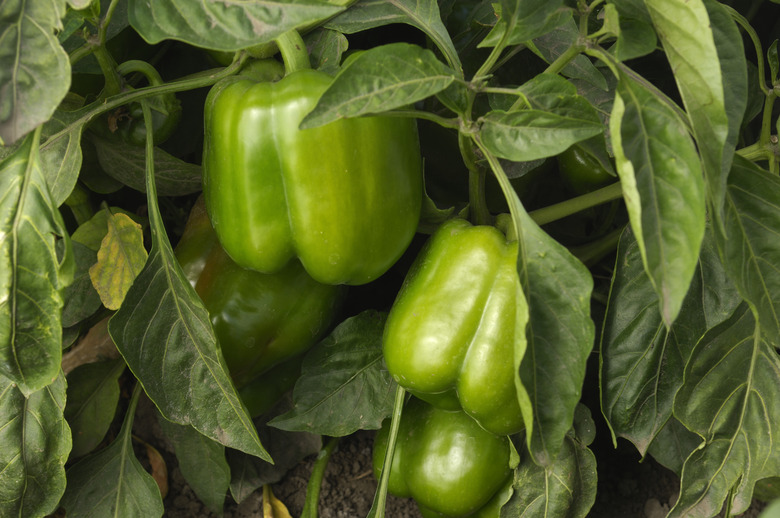Why Are My Green Peppers Turning Black?
We may receive a commission on purchases made from links.
As a vegetable gardener, you're probably familiar with the good feeling most gardeners get from growing their own crops, but you also have your fair share of questions, such as why are my green peppers turning black? It's disappointing to see garden produce such as annual green peppers (Capsicum annuum) develop black areas and stop growing when they're only partially formed. Several problems can cause blackening of pepper fruits. So identifying the specific cause is an important first step in dealing with the problem and saving the remaining crop.
Tip
Reasons that your peppers are turning black may include fungal diseases, viral infections or blossom-end rot.
Green Pepper Diseases
Green Pepper Diseases
Peppers grow best when planted on well-draining soil and full-sun exposure. Most pepper types, including bell pepper, start setting fruits about six weeks after they're planted. The fruits gradually enlarge and, depending on the variety, may stay green or turn yellow, orange or red when fully mature. Although usually trouble-free plants, peppers can be susceptible to plant diseases that may damage and discolor their fruits, resulting in green peppers turning black.
Green Pepper Fungal Problems
Green Pepper Fungal Problems
Several fungal disorders can result in ripening green peppers turning black. One of the disorders is anthracnose, which leads to round lesions on pepper fruits. The lesions sometimes have black rings in their center and can enlarge enough to cover and collapse entire fruits.
Another fungal disease, called Phytophthora blight, also can cause black areas on pepper fruits, with those areas eventually covering entire fruits. Phytophthora blight also produces black areas on pepper plant stems and overall wilting of the plants.
The best way to prevent fungal problems is to inspect transplants carefully and choose only those without any wilted or damaged leaves. Also, choose varieties certified as disease-resistant. Water the plants at their bases to keep foliage dry, which helps prevent fungal growth, and space the plants at least 18 to 24 inches apart to give them good air circulation.
Once you see signs of a fungal problem, you might be able to save the plant by pruning and discarding its affected parts, cutting behind diseased areas and into healthy tissue with sharp pruning shears that you wipe with rubbing alcohol before each cut to prevent spreading the disease. If the entire plant is affected, discard it to prevent the fungus from spreading to other plants. It's also helpful to rotate planting areas because fungi live in the soil and can reinfect the next year's crop.
Green Pepper Viral Infection
An infection caused by the tomato spotted wilt virus may cause light-colored rings on pepper fruits, and the rings may slowly turn black. The affected plant's leaves become bronze-colored and wilt, and a severely infected plant could die. This virus is spread by thrips, a tan or yellowish brown insect about 1/25th inch long.
If you see thrips on your pepper plants, you can try spraying them with ready-to-use insecticidal soap. You may want to test the spray on a small area of a plant, however, because some tomato plants are sensitive to insecticidal soap, which may damage your plants. Use the spray on a windless day when the temperature is at or below 90 degrees Fahrenheit. If an entire plant shows symptoms of the virus, it's best to discard it, because there's no cure for viruses. It's safe to spray insecticidal soap up to the day of harvest, but don't spray more than three times within a two-week period.
Blossom-End Rot in Green Peppers
Blossom-End Rot in Green Peppers
A problem called blossom-end rot is another possible cause of green peppers turning black in spots. Each spot looks sunken and rotted, and it appears on the fruit's blossom end, not the fruit's stem end. If you see a small, black spot on an otherwise healthy pepper fruit, then it's fine to pick the fruit and use its unaffected areas, but discard its blackened end. If the damage involves most of a fruit, then pick and discard that fruit, allowing the plant to put its energy into other, healthy fruits.
Blossom-end rot develops when the soil is poor in calcium or when plants have difficulty using the calcium that's present. The best way to prevent the problem is to avoid moisture stress to the plants by ensuring they get at least 1 inch of water weekly. Add about a 2-inch-thick layer of mulch on the soil surface under each pepper plant to conserve soil moisture, pulling the mulch back a bit from every plant's stem to discourage fungal growth at the base of plants.
If you encounter blossom-end rot in your pepper plants, check the soil's pH level with a soil test kit before the next growing season, ensuring that it's pH 6.5 to 6.8, a level that helps make soil calcium available to the plants. If necessary, pre-treat the soil the next spring as recommended in the soil test result.
